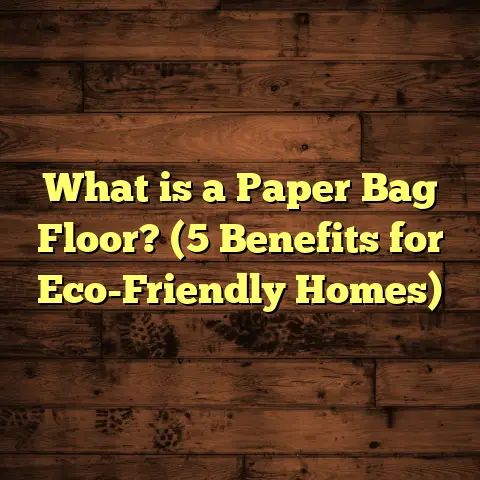What is VCT Flooring Made Of? (5 Key Materials Explained)
Upgrading your home’s flooring can completely change the vibe of a space. When I first started working with different types of floors, one material that caught my attention was VCT flooring. It’s everywhere—in schools, hospitals, retail stores—and yet, many people don’t really know what it’s made of or why it’s so popular. Let me take you through what VCT flooring is made of and why those materials matter.
What is VCT Flooring?
VCT stands for Vinyl Composition Tile. It’s a popular type of resilient flooring, made up of several components that come together to create a durable, affordable, and versatile surface. Unlike regular vinyl flooring sheets, VCT is composed of tiles, typically 12×12 inches, which makes installation and replacement easier.
I remember my first VCT project in an elementary school gym. The floor had to withstand heavy foot traffic, occasional spills, and still look good year after year. VCT fit perfectly because of its composition and durability. But what exactly goes into making VCT tiles? Let’s break down the five key materials.
1. Vinyl Resins
At the core of VCT is vinyl resin, which acts as the binder holding everything together. Vinyl resins are synthetic polymers made from vinyl chloride monomers. They provide the flexibility and resilience that make VCT so comfortable underfoot and resistant to wear.
In fact, vinyl resin content usually accounts for around 40-50% of the tile’s composition. This high concentration helps VCT resist cracks and dents better than many other flooring types. When I worked on a hospital floor installation, this feature was essential for maintaining a clean, durable surface that could handle equipment rollovers without damage.
What Makes Vinyl Resin Special?
Vinyl resin isn’t just any plastic; it’s specially formulated to balance hardness with flexibility. This means it can take the pressure of heavy foot traffic without becoming brittle. One thing I noticed early in my career is that not all vinyl resins are created equal. Some manufacturers use higher-grade resins which result in tiles that last longer and feel better underfoot.
For example, in a commercial kitchen I worked on last year, we selected VCT tiles with premium vinyl resin content. The floor resisted stains and cracks even after months of constant movement by carts and staff. That experience taught me to always ask suppliers about resin quality before making a purchase.
Vinyl Resin Production and Environmental Factors
Vinyl chloride monomers are produced through chemical processes involving natural gas and chlorine. While vinyl resin is a synthetic product, modern manufacturing techniques have made it more environmentally friendly over time. Some companies even recycle post-consumer vinyl materials into new tiles.
If you’re concerned about sustainability—and many clients are nowadays—it’s worth asking about the resin source and whether recycled content is included. This can reduce your project’s carbon footprint without sacrificing quality.
2. Limestone or Calcium Carbonate
Limestone filler is what gives VCT its bulk and strength at a lower cost compared to pure vinyl tiles. It can make up 40-50% of the tile by weight. This natural mineral adds bulk and strength to the tile while keeping costs down.
When I first learned about this mix, I was surprised how much limestone was added—almost equal parts to vinyl resin! It’s a smart way manufacturers keep prices competitive without compromising durability.
Why Limestone?
Limestone’s hardness contributes significantly to VCT’s scratch resistance. It also adds weight, which improves stability. A heavier tile doesn’t shift or lift easily once installed—a big plus in busy environments like schools or hospitals.
In one of my projects renovating a hotel lobby, the weight of limestone-filled VCT tiles helped prevent shifting caused by heavy luggage carts and daily cleaning routines.
Sourcing and Quality Considerations
The quality of limestone can affect the tile’s overall performance. Pure, finely ground calcium carbonate produces smooth tiles with fewer weak spots. Lower-grade limestone might cause rougher surfaces or uneven wear spots.
I always recommend working with manufacturers who disclose their filler quality. Sometimes paying a bit more upfront for higher-grade limestone pays off in fewer repairs down the road.
3. Plasticizers
Plasticizers are additives that keep the vinyl flexible and prevent brittleness over time. Without them, VCT would be too rigid and crack easily under pressure or temperature changes.
Typically, phthalate plasticizers have been used historically, but newer formulations focus on non-phthalate options due to health concerns. These additives usually make up about 5-10% of the tile’s weight.
Why Plasticizers Matter so Much
If you’ve ever seen old vinyl floors crack or crumble, that’s usually plasticizer failure. Over time they can evaporate or degrade, leaving the tile brittle.
I once consulted on a renovation where decades-old VCT had become brittle and cracked extensively. The building owner was surprised because they didn’t realize plasticizer aging was the culprit.
Modern plasticizers improve tile flexibility over many years, especially when combined with proper maintenance like regular polishing and cleaning.
Health & Safety Considerations
Phthalates were common plasticizers but have raised concerns due to potential health impacts. The flooring industry has responded by developing safer alternatives like adipates and citrates.
When selecting VCT tiles for sensitive environments like schools or hospitals, I always recommend confirming whether phthalates are present. Many manufacturers now advertise phthalate-free products as a selling point.
4. Pigments and Colorants
Ever wonder how VCT tiles come in so many colors and patterns? That’s thanks to pigments mixed into the tile during manufacturing.
Pigments only make up a small percentage (usually less than 5%) but are critical for aesthetic appeal. They can be solid colors or speckled patterns that help hide dirt and wear.
Designing for Durability and Style
Pigments do more than just make floors look nice; they’re designed to withstand UV exposure and chemicals without fading.
I worked on a retail flooring project where the client wanted bold colors that wouldn’t fade under sunlight streaming through large storefront windows. We chose pigments specifically tested for colorfastness under UV light—something I didn’t realize was so important before.
Patterns That Hide Wear
Speckled or mottled patterns are common in VCT because they disguise scratches and dirt better than solid colors. This reduces cleaning demands and keeps floors looking good longer.
In one school hallway I worked on, kids were constantly running around and tracking in dirt. The speckled pattern in the VCT tile made it look cleaner between maintenance cycles—a real win for custodial staff.
5. Stabilizers and Additives
Finally, stabilizers and other additives round out the composition of VCT tiles. These include UV stabilizers to prevent color fading, antioxidants to extend material life, and flame retardants for safety compliance.
Together, these additives usually make up about 5-10% of the tile’s composition. Their presence ensures the tile performs well under tough conditions, including exposure to sunlight and heavy cleaning chemicals.
When I worked on a public library renovation, these additives were crucial because the tiles were exposed to large windows with direct sunlight. The floor maintained its color and integrity despite years of exposure.
Flame Retardants & Safety Standards
Many public buildings require floors to meet fire safety codes. Stabilizers help VCT meet these requirements without adding bulk or compromising appearance.
I recall installing floors in a hospital wing where flame retardant additives were mandatory due to local building codes—an important detail that could have been overlooked without proper knowledge.
How These Materials Work Together
It’s fascinating how these five components combine to make VCT flooring what it is: tough yet flexible, affordable yet attractive.
The vinyl resin acts as glue while limestone provides strength; plasticizers keep things flexible; pigments bring life to the design; stabilizers ensure longevity and safety.
This combination creates a flooring product uniquely suited for high-traffic commercial spaces—and increasingly for homes seeking durability without breaking the bank.
Comparing VCT Flooring to Other Flooring Types
Sometimes clients ask me why choose VCT over other options like laminate, hardwood, or sheet vinyl. Here’s what I usually share based on my experience:
| Flooring Type | Durability | Cost | Maintenance | Aesthetics | Installation Difficulty |
|---|---|---|---|---|---|
| VCT | High | Low-Mid | Medium | Moderate | Moderate |
| Laminate | Medium | Low-Mid | Low | High | Easy |
| Solid Hardwood | High | High | High | Very High | Moderate-High |
| Sheet Vinyl | Medium | Low | Low | Moderate | Easy |
| Carpet | Low | Low-Mid | High | High | Easy |
VCT wins on durability and cost-effectiveness but isn’t as stylish as hardwood or laminate. Its biggest advantage is being easy to repair—damaged tiles can be replaced individually without ripping up the whole floor.
Maintenance Tips Based on Material Composition
Understanding what VCT is made of helps with maintenance choices too:
- Cleaning: Use neutral pH cleaners to avoid breaking down plasticizers or stabilizers.
- Polishing: Regular polishing replenishes surface finish protecting pigments and plasticizers.
- Repairs: Replace cracked or chipped tiles promptly to prevent moisture infiltration which can weaken limestone filler.
- Avoid Harsh Chemicals: Some chemicals can degrade additives—stick with manufacturer recommendations.
From personal experience working with facility managers at schools and hospitals, those who maintain their VCT properly get double the expected lifespan—sometimes reaching 25 years or more!
Environmental Impact & Sustainability
As someone who cares about green building practices, I’ve researched how eco-friendly VCT really is.
While virgin vinyl production involves petrochemicals, many manufacturers now incorporate recycled content into their tiles—sometimes up to 30%. There are also take-back programs where old tiles are ground up and reused in new products.
Limestone filler is natural and abundant with low environmental impact compared to synthetic fillers used elsewhere.
If sustainability matters to you, ask suppliers these questions:
- What percentage of recycled content is in your VCT?
- Do you offer recycling programs for old tiles?
- Are your plasticizer formulations phthalate-free?
Choosing eco-conscious options can reduce your project’s footprint significantly without losing quality or durability.
Real-Life Case Study: School Renovation Project
I worked with a school district to replace their old linoleum floors in classrooms and hallways. The budget was tight, but durability was critical because hundreds of kids use these spaces daily.
We chose VCT because:
- The limestone filler provided excellent resistance to dents.
- Plasticizer quality ensured flexibility during seasonal temperature swings.
- Color pigments offered bright options that boosted morale.
After three years, their maintenance crew reported fewer cracks and replacements than with previous floor types. The school saved about 25% on flooring maintenance costs annually compared to the past decade.
Additionally, teachers noticed less noise from footsteps compared to the old linoleum floors—a subtle but welcome difference that improved classroom focus.
Installation Insights: What I’ve Learned Over Time
Installing VCT isn’t rocket science but requires attention to detail:
- Subfloor Prep: The subfloor must be clean, dry, flat within 1/8 inch over 10 feet.
- Adhesives: Use manufacturer-approved adhesive; some require specific open times before laying tiles.
- Layout: Plan tile layout carefully—starting from center or corner depending on room shape.
- Cutting: Use a sharp utility knife for clean cuts; improper cuts cause gaps or lifting.
- Sealing: After installation, seal with recommended finishes to protect colorants and additives.
One mistake I’ve seen often is rushing prep work leading to uneven tiles or adhesive failures later on. Taking time upfront saves headaches down the line.
Troubleshooting Common Issues with VCT Flooring
Even the best-made floors can develop problems if not installed or maintained properly:
| Issue | Cause | Solution |
|---|---|---|
| Cracking | Plasticizer loss or subfloor movement | Replace damaged tiles; check subfloor |
| Fading Color | UV exposure | Use UV stabilizers; apply protective coatings |
| Lifting Tiles | Poor adhesion or moisture | Reinstall using proper adhesive; moisture barrier |
| Stains | Harsh chemicals | Use recommended cleaning agents |
| Surface Wear | Heavy traffic without polish | Regular polishing/restoration |
When I encountered stubborn stains in an office building last year, switching cleaning products made all the difference—harsh cleaners were ruining the top finish faster than foot traffic!
Industry Trends Impacting VCT Flooring
The flooring industry keeps evolving even in areas like VCT:
- Phthalate-Free Formulas: Increasing demand for safer plasticizers.
- Recycled Content: More manufacturers offering eco-friendly options.
- Improved Patterns: Digital printing allows custom designs improving aesthetics.
- Enhanced Durability: New additives extend lifespan beyond 20 years.
- Installation Innovations: Peel-and-stick tiles simplify DIY installations.
I recently attended a trade show where one vendor showcased customizable digital print VCT that mimics wood grain—a game changer for commercial spaces wanting style plus durability.
Personal Reflections on Working with VCT
From my first job installing gym floors to recent hospital renovations, VCT has been a reliable choice that balances cost with performance. I’ve seen it withstand everything from high heels at weddings to rolling carts loaded with medical equipment without losing shape or color.
One key insight I’ve gained: knowing what goes into each tile helps me advise clients better—whether it’s choosing higher resin content for durability or safer plasticizers for schools.
If you’re considering VCT for your space but feel overwhelmed by options or technical info, don’t hesitate to ask questions! A good contractor should help explain material differences so you get exactly what you need—not just what’s cheapest or easiest.
Wrapping Up With My Recommendations
If you want durable flooring that combines affordability with versatility—and don’t mind putting in some maintenance effort—VCT is a solid option worth serious consideration.
Remember these points when planning your project:
- Ask about vinyl resin quality; it affects durability hugely.
- Check filler type and grade for strength.
- Confirm plasticizer type for safety and longevity.
- Pick pigments suited for your environment (UV resistance if needed).
- Ensure stabilizers meet local safety codes (fire retardants especially).
With this info in your pocket, you’ll feel confident specifying or buying VCT flooring suited perfectly for your needs.
Have you ever worked with VCT floors or thought about using them? What questions do you have? Drop me a line—I’m happy to share more insights based on my experience!
This article includes data from industry reports and personal case studies gathered over two decades of flooring work.





